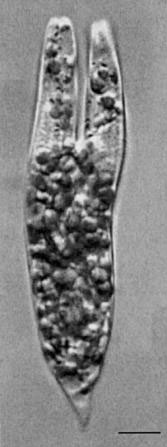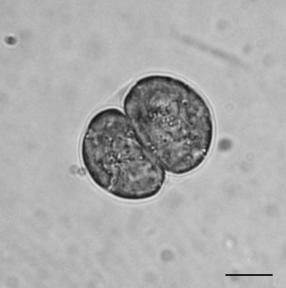Reproduction in Algae
Vegetative and asexual modes allow stability of an adapted genotype within a species from a generation to the next. Both modes provide a fast and economical means of increasing the number of individuals while restricting genetic variability. Sexual mode involves plasmogamy (union of cells), karyogamy (union of nuclei), chromosome/gene association, and meiosis, resulting in genetic recombination. Sexual reproduction allows variation but is more costly because of the waste of gametes that fail to mate.
Binary Fission or Cellular Bisection
It is the simplest form of reproduction; the parent organism divides into two equal parts, each having the same hereditary information as the parent. In unicellular algae, cell division may be longitudinal as in Euglena (Euglenophyta) (Figure 1.16) or transverse. The growth of the population follows a typical curve consisting of a lag phase, an exponential or log phase, and a stationary or plateau phase, where increase in density is leveled off. In multicellular algae or in algal colonies this process eventually leads to the growth of the individual.
Zoospores are flagellate motile spores that may be produced within a parental vegetative cell as in Chlamydomonas (Chlorophyta) (Figure 1.17). Aplanospores are aflagellate spores that begin their development within the parent cell wall before being released; these cells can develop into zoospores. Autospores are aflagellate daughter cells that will be released from the ruptured wall of the original parent cell. They are almost perfect replicas of the vegetative cells that produce them and lack the capacity to develop in zoospores. Examples of autospore forming genera are Nannochloropsis (Heterokontophyta) and Chlorella (Chlorophyta). Spores may be produced within ordinary vegetative cells or within specialized cells or structures called sporangia.
In this reproductive mode, when the coenobium/colony enters the reproductive phase, each cell within the colony can produce a new colony similar to the one to which it belongs. Cell division no longer produces unicellular individuals but multicellular groups, a sort of embryonic colony that differs from the parent in cell size but not in cell number. This mode characterizes green algae such as Volvox (Chlorophyta) and Pediastrum (Chlorophyta). In Volvox division is restricted to a series of cells which produce a hollow sphere within the parent colony, and with each mitosis each cell becomes smaller. The new colony everts, its cells form flagella at their apical poles, which is released by the rupture of the parent sphere. In Pediastrum the protoplast of some cells of the colony undergoes divisions to form biflagellate zoospores. These are not liberated but aggregate to form a new colony within the parent cell wall.






